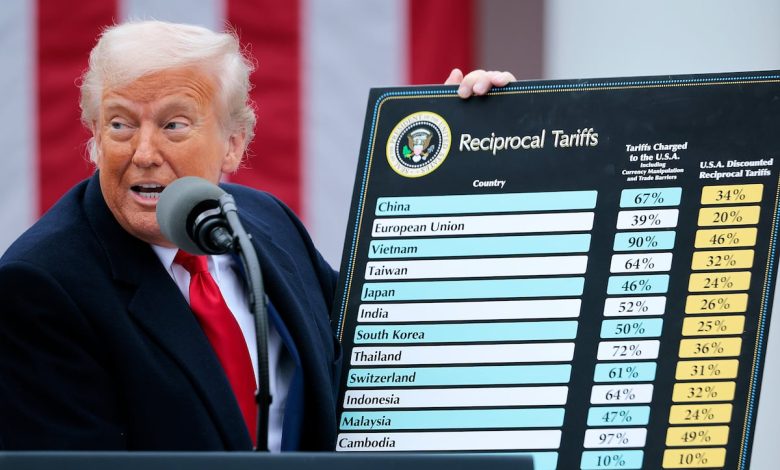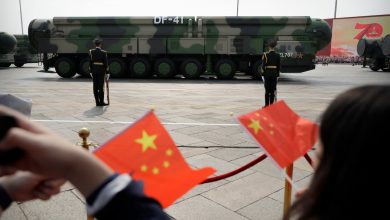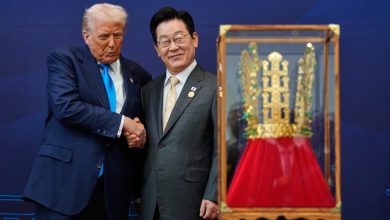Defense firms closely watching tariffs, but split on potential sting

Major defense contractors appear to be split on the potential impact of the Trump administration’s tariffs, with one major firm bracing for hundreds of millions in potential lost profits, while others predict minimal effects.
In an April 22 earnings call with investors, executives from RTX Corp. — formerly known as Raytheon — predicted $850 million in losses if tariffs stay in effect for the rest of 2025.
Executives from Boeing and Lockheed Martin, on the other hand, expressed more confidence that they will be able to blunt the worst effects of the tariffs.
Tariffs are taxes on imported goods, and the Trump administration has made them a centerpiece of its economic strategy. Customers typically pay the costs of tariffs, either directly through the tariffs themselves or through higher prices during resale.
President Donald Trump has enacted or threatened higher tariffs on most of the rest of the world, hoping to use them as diplomatic or economic leverage. Trump wants tariffs in part to drive industries to return manufacturing and production of key materials like steel and aluminum back to the United States.
RTX Chief Financial Officer Neil Mitchell said in the company’s earnings call that the $850 million loss prediction includes a potential $250 million hit from tariffs on Canada and Mexico, and another $250 million from Chinese tariffs. RTX also expects the 10% tariff on most other countries around the world could cost $300 million, and steel and aluminum tariffs could cost $50 million, he said.
Most of the pain from those tariffs would likely come in the latter half of 2025, Mitchell said, as the company draws down its existing inventories.
That $850 million estimate includes “mitigations,” or steps RTX could take to lessen the hit tariffs might deal to the company’s bottom line, RTX Chief Executive Officer Chris Calio said. Those mitigating steps could include free trade zones, refunds known as duty drawbacks and taking advantage of different suppliers and assembly sites, he said.
Many of the mitigations RTX is considering are new to the firm, Mitchell said, “because we lived in an environment where most goods were coming across the border without a duty.”
RTX is also preparing for the possibility of tariffs lasting several years, Mitchell said, and looking for ways to get the most out of its mitigation strategies.
Most of the tariff hit to RTX will be split roughly evenly between its subsidiaries Collins and Pratt & Whitney, Mitchell said, with each division absorbing slightly more than $400 million in tariff costs. RTX’s Raytheon division will likely see “minimal” tariff impact, he said.
Calio told investors that the company will pass along higher costs to customers when it can — and has done so in the past — but will have to strike a balance in the process, and consider what the market will bear.
“We have not been shy about pushing through higher costs through pricing and we’ll continue to look for opportunities to do that,” Calio said. “But it’s not a panacea for all things tariff.”
Working around tariffs
In Lockheed’s April 22 earnings call on the first quarter of 2025, Chief Executive Officer Jim Taiclet said the company’s strong start to the year would allow it to absorb potential headwinds from tariffs.
Lockheed Chief Financial Officer Evan Scott said the company will have ways in its supply chain to completely avoid tariffs. For purchases under fixed-price contracts that cannot dodge tariffs, he said, the company has mechanisms to recover the costs — but he cautioned that recovering those costs may take some time.
Boeing Chief Executive Officer Kelly Ortberg also said he hopes the company will be able to recover tariff costs through duty drawbacks.
Taiclet said legal constraints on using Chinese-sourced materials or products in defense supply chains make tariffs against that nation a nonfactor for Lockheed.
“This is, I think, a larger issue for non-defense industries that require these kinds of materials, because our supply chain contracts have specified non-Chinese sources for the materials over the decades,” Taiclet said.
Lockheed also plans to tap existing stockpiles of materials, such as rare earths, and find alternate sources, Taiclet said, and applauded the government for trying to develop U.S. sources for raw materials to make the supply chain less fragile.
“We’ve been advocating [for greater U.S. sourcing] for about four or five years,” Taiclet said. “We need U.S. sources for even basic materials like titanium, for example — certainly nonadversary sources.”
Lockheed Vice President Maria Ricciardone predicted that a disruption in the company’s rare earths supply would not hurt its ability to meet its delivery commitments for the rest of the year.
“We have sufficient quantity that’s already integrated into our value chain so it provides a bit of a buffer from potential supply chain disruptions in the near term,” Ricciardone said.
Boeing’s Ortberg also downplayed the potential risks of tariffs, saying much of the company’s supply chain is already based in the United States. Many imports from Canada and Mexico are also exempt under trade agreements, he said.
Other parts of Boeing’s supply chain, Ortberg said, have warned of price increases from tariffs, but he called them “not overly material” and an issue that could be solved.
“The thing I’m really trying to make sure we’re focused on is making sure that an argument over [who’s going to pay] a 10% tariff doesn’t turn into a continuity of supply issues,” Ortberg said. “We really need to make sure that people are buying and bringing in the parts that we’re going to need, and then we’ll work through the financial implications.”
Boeing Chief Financial Officer Brian West said the company has stockpiled a higher inventory of materials such as aluminum and steel, which typically make up 1% to 2% of an airplane’s average cost.
West also said Boeing has spent decades managing supply chains and global trade, and its officials have experience handling tariffs and duty recoveries, which makes it confident it can handle tariff turmoil.
Aviation impacts
Much of Ortberg’s comments on potential tariff impacts, such as China’s refusal to accept Boeing aircraft deliveries, touched on the company’s commercial aircraft business.
And he predicted Boeing’s cash balance on hand and production levels will allow the company to keep its business stable, even in the face of tariffs.
Ortberg cautioned the tariff situation is “dynamic,” and said aviation industry officials regularly speak with the administration about tariffs. He said they also stress that aircraft sales generate a trade surplus for the United States, and how important it is to maintain that surplus.
Ortberg said he’s “hopeful” the administration will be able to negotiate agreements with other nations that allow tariffs to be lifted.
“I don’t think a day goes by where we aren’t engaged with someone in the administration, including cabinet secretaries and up to POTUS himself,” Ortberg said. “We’re spending a lot of time making sure the administration understands the implications of either short-term or long-term tariffs on not just our company, but the overall aviation industry here in the U.S.”
Stephen Losey is the air warfare reporter for Defense News. He previously covered leadership and personnel issues at Air Force Times, and the Pentagon, special operations and air warfare at Military.com. He has traveled to the Middle East to cover U.S. Air Force operations.







